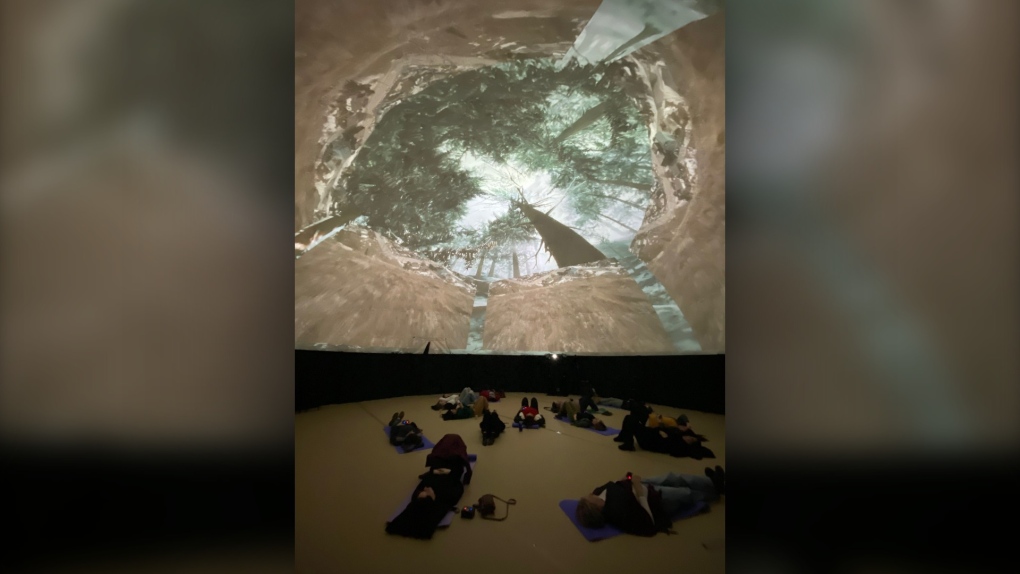A massive dome set up inside the Yukon University gymnasium is being used as a mesmerizing teaching tool providing a unique experience to kids in the north.
As students step inside the 44-foot structure, they are immersed in “The Brain” -- a 60-minute video projection-mapped to a 360-degree dome.
“It looked like you were actually inside your brain, which was pretty cool,” said Erykah Cletheroe-Blackjack, one of the dozens of students who have the opportunity to experience it.
The program takes young people through a story of the human brain, from creation to adult development. They learn how their brains react to junk food, TikTok videos, toxic stress, and most importantly, to drugs.
“It talks about opioids, where they come from, and it talks about the impact it has on your brain. And then, it talks about what can happen when you’re ingesting those types of substances,” said Tosh Southwick, co-founder of IRP Consulting. She played an instrumental role in the creation and development of the program.
More than fried eggs
“When I was growing up, there was this big campaign against drugs, (called) ‘This is your brain on drugs’ and they would fry an egg in a frying pan and then that was it,” said Southwick.
By contrast, The Brain provides “a physiological representation of walking through your neurons, your synapsis, and your different hormones -- all these different pieces in the brain,” she said.
Southwick comes from the Kluane First Nation and is a member of the Wolf Clan. She’s an active community leader and mother, and says it was important for her to see a different type of education in her community.
“We need all the solutions that we can try,” said Southwick, who described a time 18-months ago, when she would hold her breath every time her phone rang over fear of “who we lost next.”
She says her community has faced numerous deaths from the toxic drug supply. At one point last year, Yukon faced Canada’s worst toxic drug death rate.
Southwick says The Brain was a true collaboration, citing Kelly Proudfoot of Firecracker Strategies, as another concerned community member and mother who wanted to step up education for kids.
More than a dozen organizations, along with educators, health units, and medical experts formed a collective to research and draft a script and visuals to create the immersive experience.
“Most people lay down to experience the dome and it takes them 10 to 15 minutes to come back to reality,” said Paul Magnuson, “Chief Imagineer” at Big Art, the company behind the dome.
“So, the emotional side of it is amazing.”
 Audience members lay on the ground to watch 'The Brain' -- a 360-degree video projection mapped on to a large dome. (Image courtesy of Kelly Proudfoot)
Audience members lay on the ground to watch 'The Brain' -- a 360-degree video projection mapped on to a large dome. (Image courtesy of Kelly Proudfoot)
The goal is to reach teenagers and leave a lasting impression.
“No 12 to 18-year-old is going to remember everything we tell them in 60 minutes. But, you will remember the experience, and the way it made you feel, and that’s more important than anything,” said Magnuson.
Experiencing the 360-degree projection and learning about the technology is also part of the experience for students from Whitehorse and surrounding communities.
“We live in the north and our kids miss things, like planetariums or IMAX theatres, or all of those things that are tech driven,” said Southwick.
The Brain incorperates elements of Indigenous culture, traditional teachings and aspects of life in the north.
“As artists, we figure out a way to communicate some of the world’s issues. I think we’ve done a great job, providing these youth with an experience that resonates, and is relevant,” said Magnuson.
The program also focuses on healing, offering tools to young people for how to avoid stress, where to get community support for drug addiction, and lessons from elders.
“These are heavy conversations,” said Southwick. Afterwards, "let’s bring you back up and (learn about) what happens when you go drumming, what happens when you're out on the land, fishing."
For many community leaders in Whitehorse, there is no conversation more pressing right now than the toxic drug crisis.
If the project “shows one youth what happens in the brain if they take a substance, that is a win for me,” said Southwick. “If we give them factual information, if their teachers are armed with more knowledge in order to support them, that’s one less chance we’re going to have somebody else who we have to care (for), and hold their family up while they grieve.”
“The Brain” is in Whitehorse for two weeks. Talks are underway to determine where else it could be installed in Canada.





































